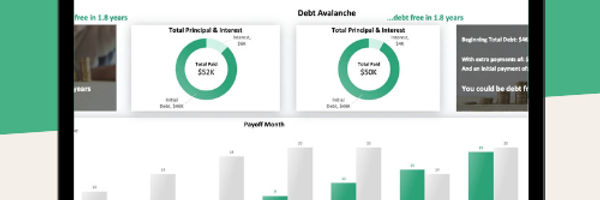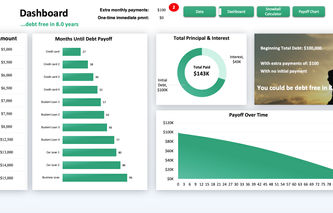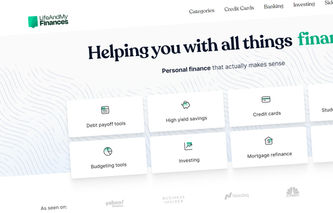Living debt-free isn’t just a mythical way of life, only heard about in far-away finance podcasts but never experienced first-hand.
Having zero debt is very real—and it can help you shed a ton of financial stress. Understanding the true meaning of being debt-free is just the start of taking down all of your debt demons.
Download tools to reduce debt:
This is our favorite tool because it contains two methods in one and you can see exactly what works for you 👇

The debt snowball or the debt avalanche? This template will give you answers 💡
This template is:
Compare which method works for YOU
Fully automated and beginner-friendly
Includes both, debt snowball and debt avalanche templates in one with all the features!

And get your finances in line:
Debt-Free Meaning
Becoming debt-free means having no outstanding financial responsibilities or debts.
For many it’s a big step towards financial freedom and getting rid of a large chunk of financial stress.
Debt can come in all shapes and sizes, including:
Personal loans
Medical bills
Car loans
Credit card balances
Mortgage loans
But the meaning of “debt-free” isn’t a one-size-fits-all.
Some argue that being debt-free means having zero debt. Many in the die-hard debt-free camp also don’t own credit cards and live in paid-for houses.
However, those with a more practical approach see credit cards as a necessary for certain transactions as long as they are paid in full and on time each month.
If you have a more casual approach, you might also exclude mortgage debt as it’s considered a “good debt” that appreciates in value over time.
But to really understand the meaning of debt-free, we have to dig a little deeper into the different types of debt—
Unsecured vs. secured debt
Secured debt involves using an asset as collateral to guarantee loan repayment.
If you can’t repay the debt, the lender can take whatever you took out the loan for to make up for the loss. Examples of secured debt include mortgages, auto loans, and secured personal loans.
Unsecured debt isn’t backed by collateral and totally relies on your credit history and promise to repay.
With no collateral, unsecured debt comes with high-interest rates and strict eligibility requirements. Examples of unsecured debt are credit card debt, medical bills, and unsecured personal loans.
If you’re considering a loan, it’s worth thinking about the type of debt you could land yourself in and the potential fallout (nobody wants to lose their car as collateral).
What’s the Difference Between Good and Bad Debt?
Diving into the subject of debt is more toe-clenching than the dreaded top springboard at the pool. But sometimes taking the plunge isn’t as bad as you first thought.
While bad debt does exist (just ask the credit bureaus), there’s also “good debt”.
But how can debt be good?
Good debt refers to loans that increase in value or generate income over time.
For example:
Student loans: Investing in education can lead to higher-paying jobs and increase your earning potential even if paying off student debt is a drag.
Mortgages: Buying a house costs a lot, but can be a smart investment, as the value of the home can increase over time.
Business loans: Investing in a business can boost your income and result in long-term financial stability.
On the flip side, “bad debt” usually involves expenses or assets that don’t appreciate in value or generate income, such as:
Credit card debt: the APR on credit cards can be very high, making it difficult to pay off the debt and leading to financial stress.
Personal loans for luxury items: Taking out a loan to pay for a luxury item, like a vacation or designer bag, can end in high-interest charges and long-term debt.
Car loans with high-interest rates: A high-interest car loan can come with a large debt burden and can take many years to pay off.
The key takeaway?
Try to avoid bad debt as it usually doesn’t count as an investment and likely won’t generate value with time.
Debt-to-Income Ratio
Still confused about what’s good, bad, or somewhere in between?
Avoiding debt altogether is a luxury that many of us can’t afford—but a simple rule of thumb is to follow the debt-to-income ratio.
The debt-to-income ratio (DTI) is used to measure your debt load compared to your income.
It’s calculated by dividing your total monthly debt payments by your gross monthly income.
For example, if your before-tax salary is $5,000 per month and you have a monthly mortgage payment of $1,300 and a credit card payment of $200, your DTI ratio would be 30%.
(All monthly debt payments) / (Gross monthly income) = Debt-to-income ratio (DTI)
Lenders use DTI ratios to assess the level of risk and if you’ll be able to pay off the loan.
A high DTI ratio tells the lender that you might struggle to make payments, while a low ratio shows you’re a low-risk borrower.
A DTI ratio of 36% or less is a good debt-to-income ratio.
A DTI ratio of 50% (or more) is a high ratio and can make it difficult for you to qualify for a loan or get better loan terms.
Download our free debt snowball spreadsheet to help manage your debt.
(Or if you want to get out of debt even faster, check out our new Get Out of Debt course.)
How Many Americans Are Debt-Free?
If you’re in debt, you can breathe a sigh of relief knowing that you’re not the only one.
The average US credit card debt among cardholders with unpaid balances is around $6,569—and the average credit card bill per month is $110.50.
In the fourth quarter of 2022, the total household debt rose by 2.4% and stood at $16.90 trillion.
Whether that makes you feel less alone or in complete disbelief, here are some more eye-opening debt figures by Northwestern Mutual:
The average US adult held $22,354 worth of debt (excluding mortgages).
As for debt sources, 20% of Americans put their monthly income primarily towards credit card debt, 18% towards their mortgage, and 8% to pay off car loans.
43% of US adults expect to be in debt for up to five years, and 20% believe it’ll take up to ten years to pay off their debt.
Between saving money and repaying debt, 57% prioritize paying down debt while 43% put savings first.
On the bright side, around 25% of Americans are living debt-free, according to a 2021 Experian survey.
How to Become Debt-Free
Being in debt doesn’t have to be like climbing up a mountain of quicksand. With the right strategies, you can even turn it into an uphill stroll.
Here are some steps you can take to get out of debt:
Make a list of all your debts: Gather all your debt statements and list all your balances, interest rates, and minimum monthly payments. Our debt snowball spreadsheet can help you understand your total debt and create a plan to pay it off.
Create a budget: Use a budget plan or money-saving app to help you manage your cash more effectively. Pinpoint areas where you can cut back and free up money to pay off debt.
Prioritize your debts: Save money on interest charges and pay off debt quickly by targeting high-interest debts. This includes credit card debt, as they tend to have higher rates.
Consider debt consolidation: We don’t recommend it as a first step, but if you’re having a hard time paying all your bills, debt consolidation may help simplify your debt and potentially lower your interest rates. A balance transfer credit card with a 0% introductory rate can also help you save money on interest charges—we recommend the Capital One SavorOne card.
Negotiate with your creditors: Contact your creditors and explain your situation—they might be willing to work out a payment plan or lower your interest rate. Some may even offer debt settlement options, which let you pay off your entire debt with just a portion of the funds.
Increase your income: Ask for a raise or start a side hustle to increase your income, which will leave you with more money to make debt repayments. You can also try online blogging or renting out a spare room on websites like Airbnb.
Be patient: Practice patience and celebrate the small wins along the way. Tracking your progress by keeping a record of your debt balances and payments can help you stay focused on your goal.
Achieving a debt-fee life is no walk in the park—you’ll need a plan, plenty of dedication, and consistent effort.
But by following these steps, you can take control of your finances and work towards becoming debt-free.
And remember—everyone moves at their own pace when it comes to paying off debt.
Amanda Stein, finance content creator, explains, “Getting out of debt is a journey, and it looks different for everyone. Never compare your story to others—we all have our own personal debt, income, struggles, and goals. There’s no one-size-fits-all, and there’ll be plenty of ups and downs along the way—just don’t let those setbacks derail your journey.”
Visit our collection for more quotes on being debt-free.
Benefits of Being Debt-Free
We’ve told you how you can get out of debt—now it’s time to get started and reap the rewards.
Being debt-free can do wonders for your financial and personal well-being.
Here are the key perks of paying off debt:
Financial freedom
Being debt-free means you have the freedom to use your income as you wish, rather than being stuck on debt repayments. You can save for future goals, invest in your retirement, or take that well-deserved vacation.
Better credit score
Paying off debt can build up your credit history—helping you to qualify for lower interest rates and boosting your chances of being approved for rental applications, employment opportunities, and insurance coverage.
Less stress
It’s no secret that debt can lead to a truckload of anxiety. In fact, seven in ten Americans say they’re stressed about their personal finances, with many living in debt.
Being debt-free can reduce your stress levels and provide a sense of financial security. You can then focus on other parts of your life, such as your family, career, or perfecting your social media captions.
Improved relationships
Financial stress can put a strain on personal relationships. A survey found that one-third of divorcees claimed debt was a deciding factor in going their separate ways.
Living a debt-free life can improve your relationships with friends and family by avoiding spats over money.
More opportunities
Having the weight of debt off your shoulders can open up more opportunities for you. You can travel, start a business, go after a new career path, or finally get a head start on your bucket list without debt holding you back.
How Being Debt Free Can Change Your Life
Still not enough to get you on track?
Here are some inspirational stories from those who’ve taken their own debt-free journey (and survived to tell the tale)—
Derek Sall, creator of Life and My Finances, revealed how he got started,
Divorce not only changed my entire life but put me $21,000 in debt. That debt represented one of my biggest failures in life, and I wanted it gone. My passion and disdain for my debt pushed me to financial freedom in just six months. Sometimes you just need to get mad at your debt to get out. Act like you’re in a boxing ring—beat it and grab your championship belt. Preferably in one round.Derek Sall, Financial expert and creator of Life and My FinancesDerek Sall
Francesca, the founder of The Money Fox, shared her secret to becoming debt-free,
What helped me the most was earning more money—I tried loads of side hustles that I’d never done before and got an extra job. Sounds like a lot—and it was! But I told myself this was only a short chapter in my life. I used the extra money to pay off debt while enjoying life’s pleasures and improving my mental health.Francesca, founder The Money Fox
Sasha Ramani, a leader at MPOWER Financing also emphasized the importance of finding extra income,
Side hustles can promote financial stability and help you become debt-free. Blogging, teaching online courses, and an SEO marketing business are a few side hustles that could lead to steady streams of revenue and help you pay off your debts.Sasha Ramani, MPOWER Financing
Financial coach, Rajat Soni, pointed out,
If you want to stay out of debt, my general rule of thumb is to pay off consumer debt as quickly as you can. If you’re borrowing money for fancy dinners or expensive cards to keep up with friends and neighbors, you’re likely taking on consumer debt.Rajat Soni, Financial Coach
You’re Debt Free—Now What?
First of all, congratulations on becoming debt-free.
Here are some steps to take now that you’ve gotten rid of all your debt troubles:
Celebrate your achievement: Take a moment to celebrate your hard work. You've accomplished a major financial milestone, and you deserve a toast (or spa weekend) to give yourself a pat on the back.
Build up your full emergency fund: Focus on building up 6–12 months’ worth of emergency savings. You never know what’s around the corner, so this fund can cover unexpected expenses, such as medical bills or car repairs—without landing you back in debt.
Save for future goals: Prioritise saving for future goals, such as a down payment on a home, a vacation, or retirement. Set specific financial goals and create a budget to achieve them.
Invest in your future: Consider investing in your future by contributing to a retirement account, such as a 401(k) or IRA. You could also start investing in stocks or make passive real estate investments to work towards long-term financial growth.
Give back to others: Donate to a charity or volunteer for a cause you’re passionate about. Giving back can give you a sense of fulfillment and help you make a positive impact on the world.
Live within your means: Try to continue living below your means, even after becoming debt-free. Stick to your budget, avoid unnecessary expenses, and prioritize saving and investing for the future.
So, is being debt-free worth it?
Becoming debt-free is a huge accomplishment that can open up lots of opportunities for your financial future.
By saving for future goals, investing in your future, and keeping an eye on your expenses, you can continue to achieve financial success and enjoy the benefits of a debt-free lifestyle.
Key Takeaways
The definition of being debt-free isn’t clear cut—but it generally refers to having no upcoming payments or debts that you’re required to pay.
Debt isn’t always bad and there are even some “disadvantages” to being debt-free. Taking out student or mortgage loans can put you in debt but also counts as a long-term investment.
Living with debt isn’t uncommon—with the average US adult having around $22,354 worth of debt.
Living without debt involves creating a debt-free plan, boosting your income, and paying off high-interest debts.
Once you’re free from debt, you can enjoy more opportunities and save up for future goals.
FAQs
Is it good to be debt free?
How can I become debt free by 40?
What does it mean to be debt free?
How can I become debt free in a year?
How can I become debt free in six months?
What percentage of Americans are debt free?
How can I become debt free in five years?
Sources
Horymski, C. (2023, February 24). Average Consumer Debt Levels Increase in 2022—Experian. https://www.experian.com/blogs/ask-experian/research/consumer-debt-study/
CNBC|Momentive Your Money Financial Confidence Survey. (n.d.). Momentive. Retrieved May 2, 2023, from https://www.momentive.ai/en/blog/cnbc-financial-literacy-2023/
Debt.com Survey: How Does Divorce Impact Finances? (n.d.). Retrieved May 2, 2023, from https://www.debt.com/research/divorce-survey/
Household Debt and Credit Report—FEDERAL RESERVE BANK of NEW YORK. (n.d.). Retrieved May 2, 2023, from https://www.newyorkfed.org/microeconomics/hhdc
Newsroom | Northwestern Mutual—Planning & Progress Study 2022. (n.d.). Newsroom | Northwestern Mutual. Retrieved May 2, 2023, from https://news.northwesternmutual.com/planning-and-progress-study-2022








.jpg)




